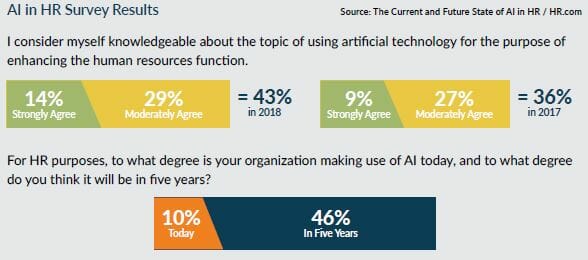Pervasive digital transformation has game-changing implications for employees and the skills they need to stay relevant. According to PwC, 38% of global CEOs are extremely concerned their business growth is threatened by their workers’ lack of key skills. The World Economic Forum predicts that more than half of all workers will need reskilling and training to address the changes created by intelligent automation and artificial intelligence (AI).
In response, human resources and talent development functions are driving training initiatives, equipping employees with the skills they need to adapt and drive the business forward.
Human resources organizations are also being up-ended by digitization. We’re already seeing the impact in entry level recruiting roles replaced by smart technologies that can screen and scan candidates using algorithms, for example. Nearly all HR services can be automated to a degree. From predictive analytics that assess where future talent needs may exist to chatbots that provide benefits services to employees, the opportunity to supplement HR roles with technology is nearly endless.Who, though, is responsible for ensuring that HR teams themselves aren’t left behind, with jobs lost to – or made irrelevant by – automation and digitization?
That’s us. The human resources, talent development and people team leaders. We are staring down the task of building HR teams of the future – organizations that are agile, flexible, and can coexist effectively with tools like chatbots. Adding to this complexity is the need to meet the changing demands of today’s and tomorrow’s workforce, digitally native Gen Y [millennials] and Gen Z.
So, how do we adapt?
At Medidata, we’re on our journey to ensure our people team (our HR team) of 65 is equipped to best function in this new environment, increasing our organization’s agility for future success.
Create a people strategy
At Cisco, and now at Medidata, I’ve architected comprehensive people, or talent, strategies aligned to driving business outcomes. All our work ladders into this, keeping us focused on how we can support our people, encourage growth, collaboration and inspire them to do great work in this changing, ever-digitizing world. This strategy applies to every single employee, whether they’re in a lab or in a remote office.
At Medidata, our strategy is to accelerate our business growth and achieve our patient mission by creating exceptional talent programs and a workplace where people are inspired, risk-taking is encouraged, and innovation thrives. This comes to life in five pillars:
- Build & Inspire Great Teams
- Create an Amazing Talent Brand and Employee Experience
- Thought Leadership & Innovation (for our people team)
- Drive Digitization and Insights
- Create a Better World.
In particular, our Digitization and Insights pillar addresses not only how our people connect to technology but how we utilize predictive analytics and other smart technologies to supplement and advance our work.
Train on change management
Plenty of resources exist to help build the curriculum your team needs to adapt and evolve. At Medidata, we’re exploring a range of development programs including The Bersin Academy, Future Workplace AI and My HR Academy. We’re working with industry thought leaders (in many cases, my peers at other companies) to create Journey Maps, highlighting “Moments that Matter” for our people team. And, we’re sending our teams to conferences and events like UNLEASH, HR Tech and others to learn from the industry and engage in constructive dialogues about how digitization and AI are disrupting – and creating opportunity for – HR.
Acknowledge generational differences
For the first time ever, we have five generations in the workforce. Digitally native millennials and Gen Z are becoming a larger percent of the workforce. Those groups have specific ways they like to consume information, for example, in formats like memes, quizzes and videos. Gen Y and Gen Z also expect on-demand access and support, much like we see in the consumer economy. Consider these expectations and needs in how you build connections between HR teams and employees and realize that many of your HR teams may lack the demographics of the employees they support.
 Educate on AI
Educate on AI
There’s a gap between HR knowledge of AI and our expectations of its impact. According to the TLNT.com report, What Artificial Intelligence Means for Human Resources, only 14% of HR professionals believe they are knowledgeable in AI. Yet, 46 % feel they will be using AI at a high degree by 2023. Without understanding what AI is, we are far less likely to adapt effectively. Educating your team can start with something simple – share a great article on AI in the workplace or bring a thought leader in to speak. We had the whole team read Jason Averbook’s book, The Ultimate Guide to a Digital Workforce Experience: Leap for a Purpose.
Understand the implications
Digital transformation is ongoing and thus brings uncertainty. The four steps above are helping us to manage that uncertainty and ensure our HR organization has the agile mindset we need for today, and tomorrow.
What is clear today is that as smart technologies move deeper into the core of our business, we need to ensure there is a focus on algorithms that are fair, interpretable and based on valid data sets. AI must support our goal to create belonging in the workplace.
And across the board, AI will supplement, not entirely replace humans in HR. People are the core of our business and it is our HR teams that need to be most effective in stepping into the strategy, consulting and business areas that drive growth and positive experiences for our companies. As CHROs and talent leaders, we need to stop watching the trend and start preparing our teams for their new role.
